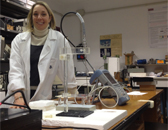Science: Caterina Merla Awarded a fellowship under Marie Sklodowska-Curie Actions
30/3/2015
The ENEA researcher Caterina Merla has been awarded a research fellowship under the Horizon 2020 - European Marie Sklodowska-Curie Actions – Research Fellowship Program
 Caterina Merla, ENEA researcher of the Technical Unit Technical Unit for Radiation Biology and Human Health (UTBIORAD), headed by Carmela Marino at the Casaccia Research Centre, has been awarded a research fellowship under the Horizon 2020 - European Marie Sklodowska-Curie Actions – Research Fellowship Program. Caterina Merla will work in one of the world’s leading cancer treatment centres, the Paris-Sud University’s Integrated Cancer Research Institute (headed by Dr L. M. Mir) in Villejuif, of the Centre National de la Recherche Scientifique (CNRS) - Institut de Cancérologie Gustave Roussy (IGR).
Caterina Merla, ENEA researcher of the Technical Unit Technical Unit for Radiation Biology and Human Health (UTBIORAD), headed by Carmela Marino at the Casaccia Research Centre, has been awarded a research fellowship under the Horizon 2020 - European Marie Sklodowska-Curie Actions – Research Fellowship Program. Caterina Merla will work in one of the world’s leading cancer treatment centres, the Paris-Sud University’s Integrated Cancer Research Institute (headed by Dr L. M. Mir) in Villejuif, of the Centre National de la Recherche Scientifique (CNRS) - Institut de Cancérologie Gustave Roussy (IGR).
She will work on a two-year research project, "Toward the comprehension of primary bioelectromagnetic interactions: real time non-linear OPTICal imaging of BIO-samples under ElectroMagnetic exposure (OPTIC BIOEM)”, which will give rise to a fruitful collaboration with ENEA-UTBIORAD.
Temporary ENEA researcher since August 2013, Caterina Merla had already collaborated with UTBIORAD thanks to a research grant by the Inter-university research centre on the interaction between electromagnetic fields and biosystems (ICEmb) of the University of Genoa, which had its headquarters at ENEA-UTBIORAD as partner of the Italian Network.
Before coming to ENEA, Caterina worked in the United States at Lehigh University (2012) and carried out her post-doc studies (2008-2010) in France, at the XLIM Research Institute, CNRS-University of Limoges, France, excellence centre for the application and study of microwaves and optical frequencies.
Caterina carried out her doctoral studies from 2004 to 2008 at the Electronic Engineering Dept. of La Sapienza University of Rome, where she graduated in Electronic Engineering in 2004, when she began her studies and research on bioelectromagnetics which did characterize all of her scientific pathway.
